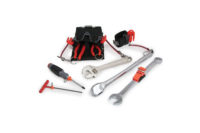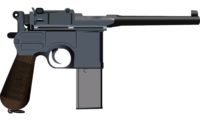You don’t need a vivid imagination to picture the dangers of a falling tool. A small 1” socket falling from a height of only 30 feet can cause great bodily injury, or even death, if it strikes someone.
Now picture that socket falling from a height of 300 feet. Clearly, anyone in its path is in serious danger – a scenario no one wants to imagine.
While many recognize the strong need for a professionally-designed tethered tool system for technicians working at height, there’s never been a true standard for industries to follow until recently. A new standard covering the use of tethering systems for retrofitted tools is providing technicians with some guidance for securing tools. Hopefully this movement will lead to the new guidance in the area of engineered attachment points on tools as well, as they provide a safer, more effective, and practical solution for working at height.
The new standard
Crafted and adopted in 2018 by industry OEMs, ANSI/ISEA 121-20181 covers four areas to retrofit tethering devices to tools:
- Anchor attachments
- Tool attachments
- Tool tethers
- Containers
The goal of this new standard was to create consistency in the safety features, weight ratings, weight rating safety margins, and testing regimens of retrofit tool attachments and tool tethers. It’s important to note that this standard only refers to the tethering devices.
A common practice among those who didn’t use any sort of professional tethering system was to DIY it using duct tape and a D-ring. This has proven to be an impractical, unsafe and ineffective solution to securing tools for a number of reasons.
For starters, tape can fray and weaken over time, and may not hold the tool if dropped. Second, there is no standard on how to tape tools; everyone is doing it differently. Finally, taping tools may impact the overall performance of that tool, as the tape may interfere or hinder the technician’s ability to fully use that tool.
While this new standard delineates appropriate tethering techniques in comparison to duct tape, string and other alternatives, use of these retrofitting protocols is voluntary and not enforceable by regulatory bodies such as OSHA, providing little comfort to anyone who happens to be below the tool.
Drop prevention systems do exist
Reliable drop prevention systems are now needed more than ever. According to the U.S. Department of Labor Bureau of Labor Statistics2, 278 people were killed from being struck by falling objects or equipment in 2018 – which represents an increase of 41 deaths from 2017’s total. The most effective way to secure tools from dropping is to use tools that are engineered specifically for working at height.
New technologies for drop prevention are emerging that focus on maintaining or enhancing a tool’s functionality. An important development is that these newer tethering systems are designed in conjunction with the tool – not as an ad hoc add-on. Engineered attachment points must consider the tool’s design and function to maintain or improve use when tethered.
Moreover, rigorous drop testing to certify the design of attachment points should be in place to ensure safety. Fortunately, there are innovative new offerings that do just that. Here are a few examples:
- Locking Pins – Most square drive tools and accessories are designed and manufactured with a spring-loaded ball in the square drive. In turn, a lock button engages with side lock holes drilled in sockets, extensions, and adaptors ensuring positive retention. A pin release tool is used to easily separate components in the system. This method is preferred over using quick release tools because a quick release button or collar could be depressed inadvertently, thus causing the drive tools to separate and become dangerous dropped objects.
- Rotating Tabs - Screwdrivers are fitted with stainless steel tabs that rotate freely 360° so lanyards do not get tangled around the user’s hand or the screwdriver handle. This method also leaves all of the handle surfaces available to be used for power and control, and allows the user to safely maintain three points of contact.
- Safety Coils - The stainless steel coils are installed on wrenches and slide along the wrench handle out of the way from an operator’s hand. This provides full use of the wrench’s handle, which provides reach and leverage when needed.
- Strategic Location - Removable jaws on pipe wrenches are pinned or drilled so the jaw cannot be separated from the wrench handle. This is critical because simply attaching to the hang hole already forged into the wrench handle leaves too great a risk of dropping the removable jaw.
Using a tethering device on a tool that has an engineered attachment point enables technicians to get the most of that tool.
Transporting and using tools safely
In examining ways to make drop prevention systems better for technicians, the industry has studied the most common cause of tool drops – the transfer between storage and use. More than half of drop incidents occur during this frequent action. With most systems, in order to secure a tool, the technician must first retrieve it and then clip or attach it to a lanyard. This process involves both hands and creates potential for dropped tools. When working at height, technicians should maintain three points of contact for their safety: two feet on a platform and one hand on a secured infrastructure. By using both hands to handle tools and attach the tool to a tethering device, the technician loses one point of contact.
To address this concern, tethering systems have been developed that eliminate the additional actions normally required to secure tools. An example is a tool belt in which each tool has its own pouch or holster with a tethering device already installed. This enables the technician to simply remove the tool, use it, and put it back into its place on the belt – all with one hand. Since every tool is already independently tethered, it significantly reduces the potential for drops.
Belts and harnesses can be customized to meet specific applications within different critical industries. Whether power generation, oil and gas, aviation or utilities; systems can be custom designed with the proper tools, and ordered as turn-key solutions with a single part number. Each tool is independently installed with its own tethered device and ready to be used: just open the box, put on the belt, and go to work.
Conclusion
Drafting new standards for retrofitting tethering devices to tools should help create some uniformity in how tools are used at height. Taking tethered tools one needed step further, more than 1,000 tools are now available with engineered tether points for drop prevention. By design, engineered attachment points do not interfere with tools’ functionality or productivity. In addition, with varying needs across industries, custom, turn-key solutions, such as the tool belt referenced above, make drop prevention programs more robust and simplify procurement. Safety needs to be everyone’s top concern when they enter a job site, and there’s no better way to achieve that than by using a professional drop prevention system.
References:
1. https://tinyurl.com/y6vrgjm7
2. https://www.bls.gov/news.release/pdf/cfoi.pdf



